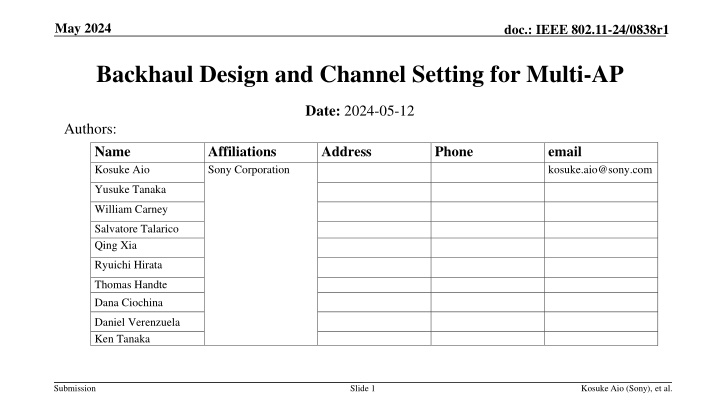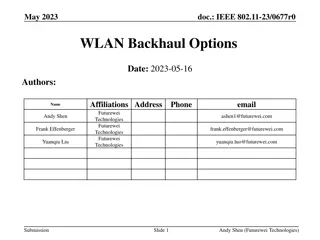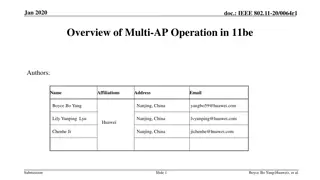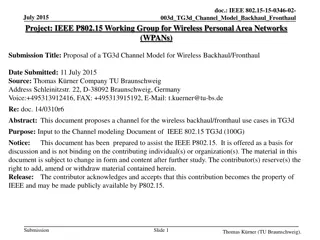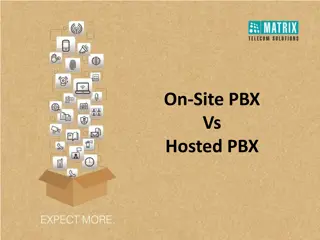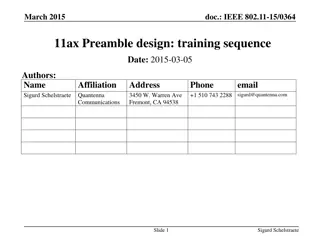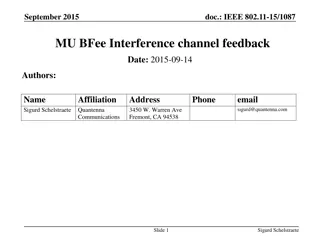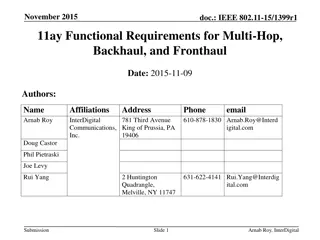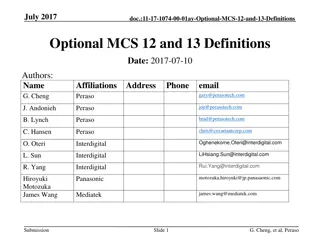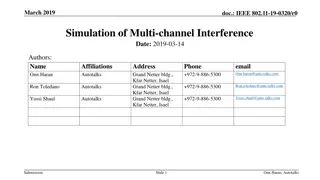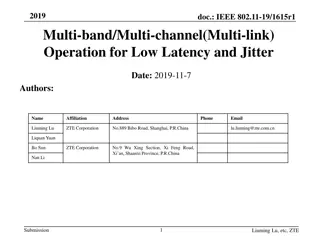Backhaul Design and Channel Setting for Multi-AP
This document discusses backhaul design and channel setting for Multi-AP in the context of IEEE 802.11 standards. It explores configurations, interfaces, and information exchange methods among multiple AP MLDs. The proposal aims to enhance coordination and efficiency in wireless network setups. Tags: Wireless networking, IEEE 802.11, Backhaul design, Channel setting, Multi-AP
Download Presentation

Please find below an Image/Link to download the presentation.
The content on the website is provided AS IS for your information and personal use only. It may not be sold, licensed, or shared on other websites without obtaining consent from the author.If you encounter any issues during the download, it is possible that the publisher has removed the file from their server.
You are allowed to download the files provided on this website for personal or commercial use, subject to the condition that they are used lawfully. All files are the property of their respective owners.
The content on the website is provided AS IS for your information and personal use only. It may not be sold, licensed, or shared on other websites without obtaining consent from the author.
E N D
Presentation Transcript
May 2024 doc.: IEEE 802.11-24/0838r1 Backhaul Design and Channel Setting for Multi-AP Date: 2024-05-12 Authors: Name Kosuke Aio Affiliations Sony Corporation Address Phone email kosuke.aio@sony.com Yusuke Tanaka William Carney Salvatore Talarico Qing Xia Ryuichi Hirata Thomas Handte Dana Ciochina Daniel Verenzuela Ken Tanaka Submission Slide 1 Kosuke Aio (Sony), et al.
May 2024 doc.: IEEE 802.11-24/0838r1 Introduction There are lot of contributions/discussion about Multi-AP in TGbn, such as Seamless Roaming [1], Coordinated R-TWT [2], Coordinated TDMA [3], Coordinated Spatial Reuse [4], Coordinated BF [5], and so on. These features assume an environment with multiple non-collocated AP MLDs, but there are differences among proposals as to what configurations are assumed. For example,.. Backhaul Design: How to design backhaul between multiple AP MLDs. Primary Channel Setting: How to set the channel for multiple AP MLDs. In this contribution, we propose a direction (idea) of backhaul design and channel setting for Multi-AP. Submission Slide 2 Kosuke Aio (Sony), et al.
May 2024 doc.: IEEE 802.11-24/0838r1 Discussion Point 1: Backhaul Design (1/3) Currently, there are two existing configurations for interfaces between AP MLDs in 11spec. 1. Over-the-Air Communicate with other AP MLDs over the air by Wi-Fi signal. 2. Over-the-DS Communicate with other AP MLDs over Distributed System (DS) via wired cable. In the future, it may be necessary to consider the new interface currently under discussion related to Seamless Roaming (This is out of scope in this document). Existing Interface New Interface Over-the-DS Over-the-Air Distribution System (DS) Distribution System (DS) AP MLD2 Virtual MLD AP MLD1 AP AP AP AP AP AP AP MLD1 MLD2 MLD3 MLD3 MLD1 MLD2 MLD3 Submission Slide 3 Kosuke Aio (Sony), et al.
May 2024 doc.: IEEE 802.11-24/0838r1 Discussion Point 1: Backhaul Design (2/3) If multiple AP MLDs can communicate via DS, it is desirable from an overhead perspective that some information be exchanged over the DS. For example.. Context(SN/PN, etc) for Seamless Roaming R-TWT Scheduling Information for SP-based coordination Resource Information for TXOP-based coordination However, it may be preferable (or even necessary) to transmit signals over the air instead of DS in the following cases Need to set NAV for surrounding STA MLDs by some signal (such as Trigger frame). Need to synchronize at RF/PHY level for simultaneous transmission (such as Coordinated SR/BF) Use case where AP MLDs are configured like a mesh network. We propose 11bn should support the information exchange between AP MLDs in both over-the-DS and over-the air cases. Submission Slide 4 Kosuke Aio (Sony), et al.
May 2024 doc.: IEEE 802.11-24/0838r1 Discussion Point 1: Backhaul Design (3/3) Regarding the "over-the-DS", some existing functions (TDLS and FST) can transmit frames defined in 802.11 as Ether frame. An Ethertype 89-0d has been assigned for IEE802.11 specification. With such an assignment, 802.11spec can define that control information/data are to be transferred over the DS. We propose to define a new payload type in Ethertype 89-0d with 11bn so that information exchanged between APs required for AP coordination can be transmitted as Ether frame. Annex.H in IEEE802.11-2020 [7] Submission Slide 5 Kosuke Aio (Sony), et al.
May 2024 doc.: IEEE 802.11-24/0838r1 Discussion Point 2: Primary Channel Setting (1/2) AP coordination is used when multiple APs share the same channel resource. Basically, multiple AP MLDs should be able to set up different primary channels [6] An AP MLD can set a different primary channel than other AP MLD when the other AP MLDs primary channel is within its own operating BSS channel. This configuration method is superior in performance to configuring the same primary channel because there is no mutual contention for TXOP on the primary channel. If AP MLD has low latency (LL) traffic and doesn t require transmission over wide-band (e.g., 80/160MHz), the AP MLD can transmit over a narrow bandwidth(e.g., 20MHz) without coordination with other AP MLDs. If AP MLD has heavy traffic and requires transmission over wide-band (e.g., 80/160MHz), the AP MLD will attempt the cooperation with the other AP MLDs whose primary overlap with the transmitted signal. Submission Slide 6 Kosuke Aio (Sony), et al.
May 2024 doc.: IEEE 802.11-24/0838r1 Discussion Point 2: Primary Channel Setting (2/2) On the other hand, depending on the distance between AP MLDs and the frequency of handover, it may be better to set up the same primary channel Over-the-air information exchange between AP MLDs should be covered in multiple primary channels. It may shorten the transmission distance because signals must be transmitted over a wide bandwidth. As for Seamless Roaming, difficult to set Dual Link because STA MLD cannot scan multiple primary channel at the same time. We propose the following condition for AP coordination channel settings in 11bn: AP MLD should at least set up the primary channel within the BSS Operating Channel of other AP MLD(s) with which it may cooperate. Whether or not to align the primary channel can be determined by some situations, such as distance between APs. Submission Slide 7 Kosuke Aio (Sony), et al.
May 2024 doc.: IEEE 802.11-24/0838r1 Summary We proposed the direction (idea) of backhaul design and channel setting for Multi-AP. Backhaul Design Information exchange between AP MLDs should support both over-the-air and over-the-DS . New Payload Type should be defined so that frames defined in the 802.11 spec for AP coordination can be transmitted over Ether LAN. Primary Channel Setting AP should at least set up the primary channel within the BSS Operating Channel of other AP(s) with which it may cooperate. APs are using the same primary channel and APs are using different primary channel. If the distance between APs is large or frequent hand-over occurs, the same primary channel is desirable. If the distance between APs is narrow and handover does not occur frequently, different primary channel is preferred Submission Slide 8 Kosuke Aio (Sony), et al.
May 2024 doc.: IEEE 802.11-24/0838r1 Update from r0 to r1 SP1: Minor change SP2: Minor change SP3: channel setting rule added limitation to at least Coordinated SR/BF (other multi-ap coordination modes are TBD) After some offline discussion, many members said that in the case of Roaming, APs should also operate on a completely separate primary channel (i.e., outside the BSS operating channel). Since other coordination schemes (especially Coordinated SR/BF with Motion Pass) are based on the assumption that the same frequency resources are used, the condition is to transmit on the same channel during wideband transmission, even if the primary channel is different. Submission Slide 9 Kosuke Aio (Sony), et al.
May 2024 doc.: IEEE 802.11-24/0838r1 References [1] 2023/1884r2, Seamless Roaming, Duncan Ho (Qualcomm Technologies, Inc.) [2] 2023/2022r1, r-TWT for multi-AP follow up, Laurent Cariou (Intel) [3] 2023/1895r2, C-TDMA frame sequence, Abhishek Patil (Qualcomm) [4] 2023/1868r2, Coordinated-Spatial-Reuse-Design, Jason Yuchen Guo (Huawei) [5] 2024/0011r0, Coordinated Spatial Nulling (C-SN) Concept, MaxLinear [6] 2020/0560r0, Multi-AP Configuration and Resource Allocation, Po-Kai Huang (Intel) Submission Slide 10 Kosuke Aio (Sony), et al.
May 2024 doc.: IEEE 802.11-24/0838r1 SP #1 Do you agree that 11bn supports the information exchange between AP MLDs in both wireless backhaul and wired backhaul? Submission Slide 11 Kosuke Aio (Sony), et al.
May 2024 doc.: IEEE 802.11-24/0838r1 SP #2 Do you agree that 11bn defines a new Payload Type for Ethertype 89-0d frame body so that Ether LAN can carry the newly defined frames in 802.11bn for exchanging information between multiple AP MLDs? Submission Slide 12 Kosuke Aio (Sony), et al.
May 2024 doc.: IEEE 802.11-24/0838r1 SP #3 Do you agree the following conditions for Multi-AP channel settings in 11bn: - AP can set a different primary channel than other AP(s) in Multi-AP coordination. - AP should at least set the primary channel within the BSS operating channel of other AP(s) in Multi-AP coordination. - Multi-AP coordination means at least Coordinate SR and Coordinated BF. Other modes are TBD. Submission Slide 13 Kosuke Aio (Sony), et al.
